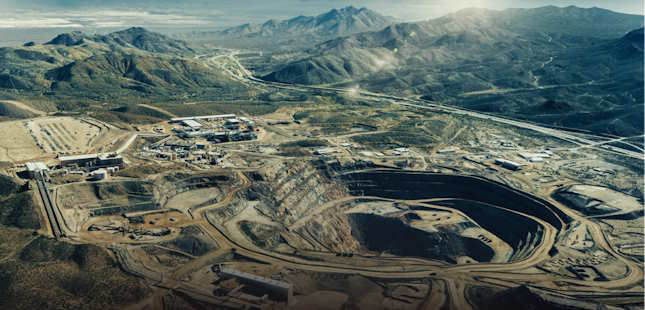Part 2 of 2. (Photo: TMY350 VIA WIKIMEDIA COMMONS)
Big digs
Demand for rare earths is expected to explode in the coming decades, driven largely by the increased need for neodymium-based magnets. These magnets, commonly made from a mixture of neodymium, iron, and boron with other elements sprinkled in, produce a stronger magnetic field with less material than other magnets available today.
While demand for neo magnets will likely triple in the coming decade, global production of neodymium will only double, according to Adamas Intelligence, a consulting firm specializing in strategic metals and minerals. It can take close to a decade to build new mines, and those long lead times could contribute to a supply crunch, says Seaver Wang, climate co-director at the Breakthrough Institute, an environmental think tank.
Short periods when demand outstrips supply can lead to volatility, high prices, and slower deployment of new technologies. In a time as fast-moving as our current energy transition, those challenging economic conditions could have far-reaching effects, potentially entrenching old technologies and stalling progress.
But despite these expected challenges and the resulting potential for volatility, there is, in theory, plenty of neodymium to go around. Despite their name, most rare earth metals aren’t terribly rare. Many are about as abundant in Earth’s crust as copper, and neodymium is roughly 1,000 times more common in the crust than platinum or gold.
However, unlike those metals, rare earths aren’t often found in concentrated deposits. Getting one ton of metal concentrate can require moving a thousand tons of rocks.
This mining and refining process can be technically complicated and environmentally damaging, in part because rare earth metals are chemically similar to each other and difficult to separate without using harsh chemicals, says Julie Klinger, an associate professor at the University of Delaware who studies the global market for these materials.
Extraction often relies on dissolving crushed-up ore in strong acid. Mines that don’t carefully contain the waste material and the used chemicals risk polluting local waterways. Rare earth mines also often need to handle radioactive waste, since elements like thorium and uranium are common in and around the minerals that are mined to extract rare earths.
There are efforts underway to mine without producing dangerous waste, and new sites are attempting to squeeze as much finished product out of their initial mined material as possible, reintroducing scraps back into the refining process so less ends up in the waste. Others are taking another look at waste from previous mining efforts.
But some experts hope to entirely rethink material supply. Instead of extracting new materials, what if we look to what’s already been dug out of the ground?
Around and around
Follow the path of many commonly used metals, and you’ll likely trace a straight line that leads from the mine to a product and, eventually, to some version of a trash can. In an effort to ease supply concerns and environmental damage, some experts are calling for a new way of using materials, one that focuses on reducing waste or eliminating it altogether.
Such a system would bend the line that goes from mine to trash into a new shape, so extracted materials are in use for as long as possible—maybe even forever. A whole host of strategies can extend the lifetime of materials, from repairing and refurbishing products to disassembling them and recycling the metals in them once the products are beyond repair.
This can start well before products even get to consumers, by making the most of materials as they’re taken out of the ground. Where recycling really gets difficult is the point at which the materials have left a company and gone into devices, says Ikenna Nlebedim, a research scientist at Ames National Laboratory.
Follow the path of many commonly used metals, and you’ll likely trace a straight line that leads from the mine to a product and, eventually, to some version of a trash can.
Today, a small but difficult-to-quantify fraction of rare earth elements are recycled from products that have reached the end of their useful life. (Many in the industry put the figure at roughly 1%, though there’s little data available on rare earth collection, Nlebedim says.) With the looming increase in expected demand, several companies, including Noveon, REEcycle, and Cyclic Materials, are working to increase that amount, setting up the beginning of a recycling industry.
A major challenge for rising magnet recyclers is that magnets tend to make up a tiny fraction of a product’s total weight. Picking through heaps of products to recover them is an imperfect system, and magnet recyclers are left with other valuable materials that they have no interest in—and no effective process for isolating.

Neodymium nitrate photographed under polarized light. GETTY IMAGES
In the future, economical recycling of rare earths might require a broader infrastructure for recycling the rest of a device, Nlebedim says. A centralized dismantling system would allow the recovery of materials like copper, gold, and platinum group metals that are often found in the same products as rare earths. This setup would allow more of the material in waste products to be reused than is possible now, when a company will go after the highest-value, easiest-to-extract materials and toss the rest into a shredder.
Quick shifts
Technology moves quickly, and many of the materials that are critical to us today weren’t even in use a century ago.
Just look at the history of Mountain Pass Mine, a rare earth mine in California. The mine’s critical product has changed every 20 years or so since production started in 1952, says Michael Rosenthal, cofounder and chief operating officer of MP Materials, the site’s owner.
In the 1960s, Mountain Pass produced the europium used in color television screens of the time. In the following decades the target was cerium, which was useful for the glass used in televisions with cathode ray tubes. Since CRTs have been replaced with new technology like LED screens, demand for cerium has decreased. Now the mine focuses on neodymium and praseodymium, another ingredient sometimes used in magnets.
Yet even as geologists are scouting new mines and companies are springing up to start building recycling systems, researchers are working to make rare earth magnets less central to our technological future, or maybe even obsolete.
Today, neodymium is necessary in these powerful magnets to wrangle the electrons in iron so that they spin consistently in the same direction, producing a strong magnetic field. There aren’t any alternatives that can match their performance.
However, there could be options on the way. Niron Magnetics is working to build iron nitride magnets, which produce a powerful magnetic field without the need for any rare earth metals. The company opened its first manufacturing facility in early 2024, and while its products can’t sub in for high-quality neo magnets just yet, there’s no fundamental reason they won’t be able to in the future. If Niron or other companies are able to develop new magnets, it could mean a shift in the rare earth market that quickly makes the current magnet recycling systems irrelevant.
In a perfectly sustainable world, we would use and reuse materials dug out of the ground indefinitely. But as our technology shifts and our lives change, it can be difficult to end the loop where it began. Instead, our material economy may morph into the shape of a spiral. Resources may not end up quite where they started— rather, the system we’ve set up to extract and use them will continue to chase technological progress, maybe endlessly.











